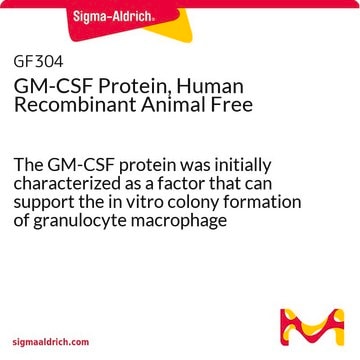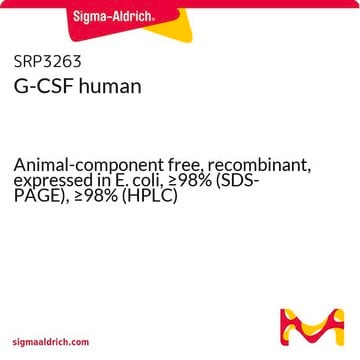G0407
Granulocyte colony-stimulating factor human
G-CSF, recombinant, expressed in E. coli, suitable for cell culture
About This Item
Productos recomendados
origen biológico
human
Nivel de calidad
recombinante
expressed in E. coli
Análisis
≥95% (SDS-PAGE)
formulario
lyophilized powder
potencia
0.01-0.1 ng/mL
calidad
endotoxin tested
mol peso
18.8 kDa (175 amino acids including N-terminal methionine)
envase
pkg of 5 and 25 μg
técnicas
cell culture | mammalian: suitable
impurezas
<1 EU/μg (LAL test)
Nº de acceso UniProt
temp. de almacenamiento
−20°C
Información sobre el gen
human ... CSF3(1440)
¿Está buscando productos similares? Visita Guía de comparación de productos
Descripción general
Aplicación
- in culturing human neutrophils
- as a growth factor component of double layer granulocyte-macrophage colony-forming unit (CFU-GM) culture system for CD34+ cells
- to test its protective effects chronic liver damage model
Acciones bioquímicas o fisiológicas
Forma física
Nota de análisis
Producto relacionado
Código de clase de almacenamiento
11 - Combustible Solids
Clase de riesgo para el agua (WGK)
WGK 3
Punto de inflamabilidad (°F)
Not applicable
Punto de inflamabilidad (°C)
Not applicable
Equipo de protección personal
Eyeshields, Gloves, type N95 (US)
Certificados de análisis (COA)
Busque Certificados de análisis (COA) introduciendo el número de lote del producto. Los números de lote se encuentran en la etiqueta del producto después de las palabras «Lot» o «Batch»
¿Ya tiene este producto?
Encuentre la documentación para los productos que ha comprado recientemente en la Biblioteca de documentos.
Los clientes también vieron
Artículos
Read article on hematopoietic cytokines and hematopoiesis
Nuestro equipo de científicos tiene experiencia en todas las áreas de investigación: Ciencias de la vida, Ciencia de los materiales, Síntesis química, Cromatografía, Analítica y muchas otras.
Póngase en contacto con el Servicio técnico










